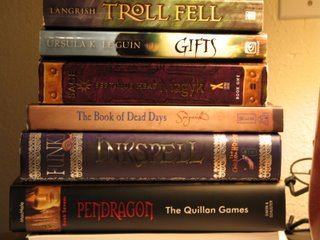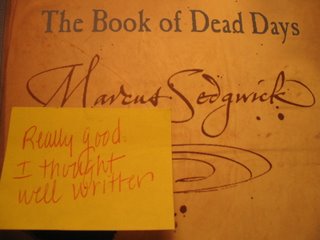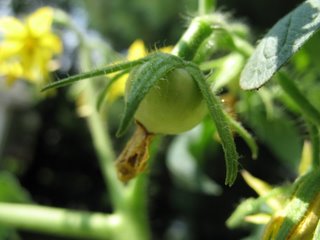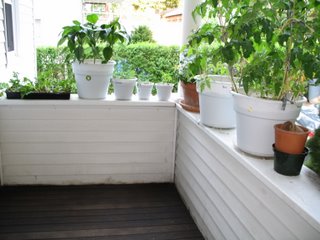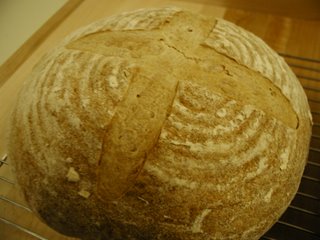Books: The No. 1 Ladies' Detective Agency
The No. 1 Ladies' Detective Agency
by Alexander McCall Smith
Quick Synopsis: Set in present day Botswana, Precious Ramotswe decides to set up the first ever Ladies' Detective Agency using inheritance money from her father. Within the first few weeks of business, she's called upon to find missing husbands, recover stolen vehicles, and follow errant daughters. As her reputation grows, Mma Ramotswe is hired to solve increasingly complicated and delicate mysteries.
This is a simple, basic, and uncomplicated book perfect for long plane rides or afternoons strapped to the elliptical machine at the gym. After the opening introduction of Precious Ramotswe's character and some background on her childhood and family, the book is essentially broken down chapter-by-chapter into the individual cases Mma Ramotswe is hired to solve. On each case, Mma Ramotswe encounters a bevy of vibrant, amusing characters, each with their own special quirks and agendas. The book is set against the backdrop of Gaborone, a small village in Botswana near the Kalihari Desert, and the geography and history of this country weaves in and out of the stories being told.
Toward the middle of the book, something started nagging me. The book reminded me of something--I was sure of it. Had I read it before and forgotten as happens to even the best bibliophile from time to time. But no, I hadn't read this book before, I was sure of it. What was it? Something about the characters, the cases Mma Ramotswe is set to solve, something about it was just so familiar. It bugged me through the rest of the book, through several sessions with the elliptical machine, and all the long waits for the #39 bus last week. I finished the book and sat frowning at the cover. And then it came to me: Encyclopedia Brown. Alexander McCall Smith has succeeded in writing an Encyclopedia Brown series for adults. All it's missing are case solutions at the back of the book--remember the letters were turned around so you had to look in a mirror to read the answer? Man, I loved those books. And I loved Precious Ramotswe and the No. 1 Ladies Detective Agency in the same simple, addicted way.
Still, case solved, book finished, I was left wanting more. As much as I adored Encyclopedia Brown as a kid and can still appreciate those One Minute Mysteries for what they were, No. 1 Ladies' Detective Agency is not a children's book and was frustrating in its lack of depth. There were a few glimmers of Truly Sensitive Subjects--wife beating, children sacrificed to witch doctors, Botswana's own complicated social and political history. But every time one of these subjects was broached, Smith quickly veered the storyline back to the sunny side of the street, wrapping everything up with a laugh and a happy ending.
It was obviously not Smith's goal in writing No. 1 Ladies' Detective Agency to spark a revolution or even necessarily to increase Western sensitivity toward Botswana culture. I feel that Smith intended to write a fun, light-hearted book that portrayed both black and white Africans as regular people who deal with straying husbands, medical fraud, and rebellious teenagers just like, well, everyone else in the world. And, heck, if he inspired just one middle-class white American look up Botswana on a map, that's an added bonus. Not every book set in Africa or written by an African (black or white--Smith was born in Zimbabwe) has to tackle the cultural and ethical minefield of African history. In fact, I'm positive there are people who have religiously read every book in the No. 1 Ladies' Detective Agency series who will probably never crack the cover of books like A Long Walk to Freedom by Nelson Mandela or even The Poisonwood Bible by Barbara Kingsolver. If Smith had gone into more detail about the South African diamond trade or the possible political corruption of some of her clients, would he have lost some of these readers?
I do think that Smith missed a literary opportunity in glossing over the hard issues. Even if he chose not to engage in a discussion of African politics, there were plenty of other universally human emotions that could have been brought to the front of his writing. Exploring these issues would have added much vibrancy and urgency to Smith's otherwise emotionally level book. In particular, Mma Ramotswe's character could have benefited enormously from a dash of complexity and a bit more soul-baring. Smith almost does this in his few mentions of Mma Ramotswe's baby who died in infancy, but never quite manages more than an 'Oh...sad. Ok, moving on!" feeling. Unfortunately, none of Smith's quirky characters are ever more than just characters, and his writing never accomplishes that literary magic of fully transporting the reader into the "here and now" of the book.
